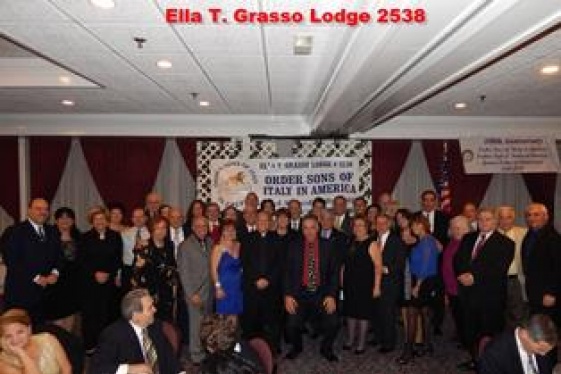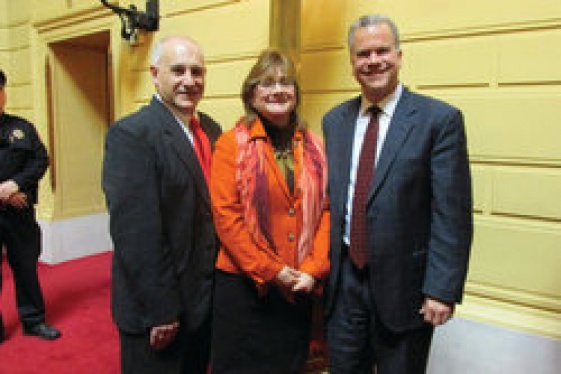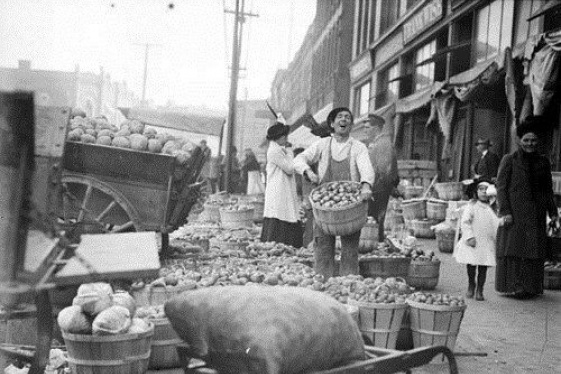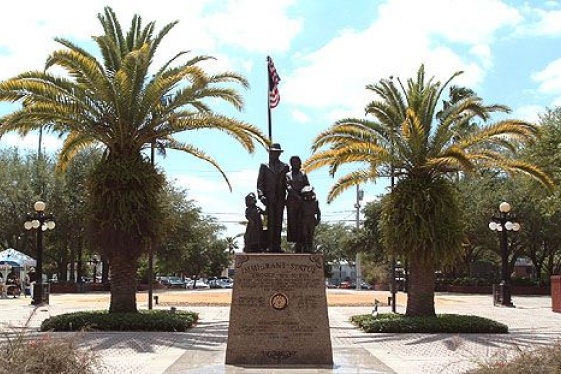
Lisa DeNatale (President of the Vermont Italian Cultural Association)
L'Italia nel Vermont è viva e vegeta, con importanti storie del passato e un interessante presente

If since the beginning of the pandemic I personally have not yet had the opportunity to physically travel back to visit any of the many friends of We the Italians scattered across the United States, thanks to our interviews I often have the chance to take a virtual trip and get to know the various Italian communities both in the most famous areas of America and in the lesser known ones here in Italy.
Vermont may be not that famous in Italy, but Italian emigration to the Green Mountain State was very important and I am pleased to thank and host Lisa DeNatale, President of the Vermont Italian Cultural Association and also Ambassador of We the Italians in Vermont. I'm hosting her on We the Italians, but by telling me about the history and present of Italy in Vermont, it's a bit like she's also hosting me in Burlington and Barre. Are you ready? Come with me
Lisa, please tell us something about you and your Italian heritage
My grandparents, Maria Tripi and Salvatore DiNatale emigrated from Pietraperzia, Sicilia in 1910. They married and settled in Boston, eventually buying a home, and raising their six children in Everett, Massachusetts.
Giuseppe Salvatore DiNatale, my father, was born in 1924. He was deeply proud of his Sicilian heritage and often sang songs and occasionally spoke to his children in Italian (not dialect). If the truth be told, he mostly spoke in the imperative! “Vieni qui”; “lasciala”; “mangia”; “andiamo subito” are some of the phrases I recall.
I had a large extended family which gathered at my grandparent’s home for Pasqua, Natale, Onomastici and almost any other occasion. I remember celebrating my father’s Onomastico with zeppole in honor of San Giuseppe. Each celebration included more people than there were chairs, crowded around tables in my grandparent’s home. As children we played bocce alongside the grape vines and pear trees in their yard and danced the tarantella.
From a young age I recall attending the Feast of Maria Santissima Della Cava, patroness of Pietraperzia, one of the many feasts celebrated in Boston’s North End each summer. In 1967 my parents and grandparents traveled together to Sicily and Italy, reestablishing family connections and invigorating our ties to Sicily. Upon returning my father began a life-long focus on preparing authentic Italian foods such as risotto milanese, calamari, polenta, pesto and panettone, well before these gained popularity in the US.
In my twenties I began to visit Italy and have since traveled there dozens of times, including twice to Sicily. It may be surprising to hear that on my first trip to Sicily, I was struck by how many of my childhood friends surnames corresponded with places in Sicily such as Siracusa and Mondello, and how many more had relatives buried in the Cimitero di Pietraperzia. I understood then how much of my childhood was inextricably tied to Sicily.
I am currently pursuing my Italian citizenship and am awaiting my appointment at the Boston Consulate schedule for March 2022.
You are the President of the Vermont Italian Cultural Association. Please tell us about the history and the activities of this association
The Vermont Italian Cultural Association was founded in 1983 by Italians and Italian Americans many of whom had relocated to Vermont in the late 70’s. Dr. Ken Ciongoli, an Italian American born in Philadelphia and Dr. Mario Morselli, born in Bologna, were lecturing about Italy in Burlington, Vermont and attracted interest from the community and in particular from other Italians and Italian Americans in the area. Some of the early VICA members were new to Vermont and sought an Italian community in which to continue their family traditions and celebrate their Italian heritage. In time, a small group formed, drawn together by a mutual passion for preserving and sharing Italian culture. During the early years the group met in living rooms and later, in restaurants and community centers that could accommodate the growing numbers. Membership extended south to Barre and Rutland; communities steeped in Italian heritage. The growing community shared the bond of family and Italian traditions and preserved these for generations to follow.
VICA has for many years celebrated Epifania with a visit from La Befana and Carnevale which included a mask making activity. In addition, VICA has sponsored trips to Italy as well as opera excursions to Montreal, a short 90-minute drive from Burlington. Programs and activities have expanded over the years, ranging from lectures on art, travel and genealogy to film, cooking, dance, language groups and bocce tournaments. Monthly amici lunches bring together members for socializing, and Italian conversation groups have continued in classrooms, in coffee shops and on zoom.
More recently, VICA has turned to virtual events which have proven to be very popular. These include book readings hosted by Phoenix Books, a VICA partner, featuring Vermont authors Vincent Panella, Jay Parini and Charlie Nardozzi, along with travel author Carla Gambescia. A recent lecture on Slow Food with the Slow Food Vermont chapter attracted over 100 people and earlier this year VICA held two virtual presentations entitled In Pursuit of Italian Citizenship, attracting over 200 VICA and community members.
And because Vermont winters can be cold and snowy in December 2020, and almost bi-monthly since then, we’ve co-hosted virtual wine-tastings with VICA partner Trattoria Delia, showcasing Italian wines from every region. In celebration of Women’s History Month in March we featured wines produced by women in Italy. Participants were treated to personal video messages sent from three producers: Cinzia Sommariva, Elisa Sesti and Giulia Negri. Each event includes a selection of hand-curated antipasti prepared locally. These events have proven to be enormously popular, engaging our members and successfully recruiting others to VICA. Upcoming events include virtual cooking classes, opera lectures and a trip to Puglia in October 2022.
Promoting knowledge and appreciation of Italian culture in our community is at the heart of the Vermont Italian Cultural Association's mission. Each year VICA awards small grants and scholarships to support projects and endeavors consistent with VICA's mission. The VICA Scholarship and Grants Fund encourages those who are seeking to broaden their knowledge of Italy, including the Italian American experience, the Italian experience, its language, arts, music, history, and culture to apply. Most recently (prior to covid) two scholarships were awarded. One went to a University of Vermont student who participated in an archaeological and agronomic research project at an ancient Roman villa in the commune of Mompeo in the Lazio region. The other recipient, also a UVM student, attended an archaeological field school in Badia Pozzeveri in Tuscany, where she participated in the excavation of the remains of a thirteenth century church. At the conclusion of each project, the scholarship recipients gave presentations to VICA members and the broader community.
In the last year VICA has become a big part of my life. On January 1st, 2021, my father passed away at the age of 96, and I wondered how I might hold onto the traditions and heritage he shared so proudly with his family. While I have only been a VICA member since 2015, and only recently was elected President, I am delighted for the opportunity to honor my father in my role. His absence has left me with a deeper commitment to VICA’s mission, and that in truth, VICA is the key to keeping my own heritage alive.
What's the story of the Italian emigration to Vermont?
I am not a historian, so I have relied on resources and information found in news articles, historical societies, and other documents. I am grateful to those writers who have shared their knowledge and perspective so that we remember the contributions of Italian immigrants to Vermont’s economy and culture. My response is based on articles from two sources and used with permission from Vincent Feeney, Vermont Historian and The (Barre-Montpelier) Times Argus.
Many people are surprised that Vermont had such a large Italian immigrant population, but one need look no further than the granite and marble quarries to understand the immigrant story. Vermont welcomed Italian immigrants beginning in the 1880’s. The first Italian stone workers came from Carrara to work at the Vermont Marble Company in Rutland. They were skilled marble carvers who were drawn to America for economic reasons and specifically to Vermont because its hills and lakes reminded them of their ancestral home.
Italians came to Barre, from 1890 to 1910 as stonecutters to work in the granite quarries. By the turn of the century there were several thousand Italians in Barre. By 1910, about 14 percent of Barre's population was Italian, and Barre was the home of Vermont's largest Italian population. Most immigrants to Barre came from the granite area around Viggiù and Bisuschio in Lombardy as well as from the marble area around Carrara in Tuscany. Some of Barre's outstanding pre-World War II carvers and sculptors were Italian immigrants: Carlo Abate, Joseph Calcagni, John Comi, Elia Corti, William Corti, Enrico Mori, Samuel Novelli, Augusto Sanguinetti, and Geno Tosi.
Other Italian immigrants came from the north as businessmen or landowners. Others from southern Italy first worked for U.S. railroads and then migrated to Barre establishing a variety of businesses. Novelli & Corti was established by Samuel ("Sandro") Novelli and Elia Corti in 1901 and also included John ("Crosta") Comi and William ("Bigin") Corti. Novelli & Corti became Barre's premier sculpture and carving studio of the early 1900s. There are many outstanding examples of the skill of Barre's carvers in monuments throughout Barre. And a walk through Hope cemetery, where many Italian immigrant stonecutters are buried, is a testament to their skills.
Later, due to a shortage of skilled granite workers a small number of master sculptors and carvers were lured from Italy through substantial wage increases to work in Barre. These artists led a renaissance of stone art in Barre and trained a whole new generation of Barre sculptors and carvers. Some of Barre's outstanding post-World War II carvers and sculptors include Angelo Ambrosini, Angelo Bardelli, Giuliano Cecchinelli, Alcide Fantoni, Flavio Furloni, Frank Gaylord, Ernesto Malnati, Orazio Marselli, Gino Sassi, and Lambruno Sarzanini.
Italian immigrants were also settling in Burlington’s urban core in large numbers, as laborers working on the railroads and others in the lumber yards. Some became peddlers selling fruit and vegetables, later opening markets to serve the growing Italian population. For the Italians of this Burlington neighborhood – despite the hardships of the Great Depression – the pre‑World War II years were something of a social/cultural “Golden Age.” Their businesses dotted the neighborhood. For groceries in general, but particularly for pasta, salami, and olives, neighbors shopped at Colaceci’s, Izzo’s and Merola’s. For a night out people dined at Bernardini’s Café, and beginning in 1941 and continuing for the next 70 years Bove’s was the restaurant to treat family and friends to an inexpensive Italian dinner.
The neighborhood was also home to Italian institutions. In 1933 Italian men of Burlington joined with their fellow countrymen of Winooski to form the Twin City Italian Club (TWIC). Its professed purpose was to “raise the standards” of the Italian community and to prepare immigrants for citizenship, but it was also a place where old-country Italian men could socialize, talk about news from home, and perhaps make job connections. By 1936 the club was sufficiently prosperous that it bought a vacant lot and built a social hall. The hall was the center of Italian social life in Chittenden County for the next dozen years. Italian women socialized in an organization called Regina of Mount Carmel, a group that attended Mass together once a month. The Regina of Mount Carmel was Mary, who for centuries had a devoted following in the impoverished south of Italy from where so many Italians had emigrated.
You've already mentioned a few, but are there other important "Italian" places in Vermont?
Barre is one of the most Italian places in Vermont, and is home to The Società di Mutuo Soccorso, founded by Italian immigrants in Barre in 1906 as a fraternal and community support group. Along with the Società, are several businesses including Vermont Salumi and (Alimentari Roscini) AR Market in downtown Barre. Peter Roscini Colman, born in Assisi to an Italian father and American mother is the founder and proprietor of both. Pete grew up on an organic farm in Vermont and spent summers in Umbria with his babbo’s family. There, he used to "warm up" for lunch at his grandparents' house by eating prosciutto. He loved it so much he decided he wanted to learn to make it himself. His uncle Franco introduced him to Pepe, who introduced him to Francesco and David. Soon, he was apprenticing with these norcini, the famed butchers of Umbria, who taught him the methods, techniques, and centuries-old traditions of salumi-making.
There’s also Campo di Vino an authentic grocery, chock full of Italian specialties made on the premises. Refrigerators are stocked with homemade pastas including ravioli, gnocchi, tagliatelle, and more; freshly stuffed luganiga and sausages as well as cannoli and pies.
Not far from Barre, located in Northfield is La Panciata, a family owned and operated wholesale bakery. Founder Glenn Loati learned the ancient art of making Latin leavened loaves of bread in Carrara, Italy where he traveled in 1992 to work in the bakery of a local market. Today the bakery is owned and operated by Glenn’s son Justin. La Panciata produces and distributes a wide variety of breads including Pane Siciliano, Pane Altamura, Focaccia and an assortment of biscotti.
Perhaps one of the most important and representative Italian places is Hope Cemetery located in Barre. Strolling through the cemetery, it’s impossible not to notice the gradual refinement of granite tombs over the course of the 20th century. The earliest gravestones are rough and weathered, as though the earth had coughed them from the ground. Many stonecutters died performing their craft, having succumbed to the "American disease" silicosis. Because the climate in Italy was milder, workers labored in sheds with open sides, naturally ventilating the area, allowing the fine dust to escape. One such stonecutter, Louis Brusa, died in 1937 at age 50 from silicosis. His monument is one of the most unusual (and disturbing) in Hope Cemetery. Brusa is shown exhausted and slumped backward with his wife Mary comforting him. His chest is merged into the granite base symbolic of his lungs filled with granite dust. Looking around, the names on the tombstones conjure far-away places: Columbo, Benvenuti, Peduzzi, Corti, and more. More than a few are engraved in Italian: Nata Novembre 1872, Morta Febbraio 1936. There are prominent mausoleums where generations of Italian families are buried side by side, close in death as in life.
Not so much a place but a philosophy is Slow Food, the movement founded by Carlo Petrini in Turin in 1989. Vermont led the US, establishing the first Slow Food chapter here in 1998. Good, clean, fair food is a practice that has long been at the root of Vermont agriculture, respect for the land, the animals, and workers. In 2000 Carlo Petrini visited Vermont, and in 2008 Vermont began sending a delegation to Terra Madre, the most important international Slow Food event.
And what about the most representative Italians who marked a spot in the history of the Italian presence in Vermont?
I’ve already mentioned many of the sculptors who have made their mark in the cities, towns and public spaces in Vermont and elsewhere having created lasting monuments with their hands. One of the most notable Italian Americans is Vermont Senator Patrick Leahy, whose maternal grandparents were Italian immigrants. Senator Leahy is the most senior member in the US Senate and Vermont’s longest-serving Senator. He and his wife Marcelle are also VICA members.
Is there an Italian festival in Vermont?
To my knowledge there has not been an Italian festival in Vermont, however we would like to plan one for the future. I’m certain there would be a great deal of interest from Vermonters, including many from the business community. One of Vermont’s family owned and operated businesses, Torronecandy.com would be very popular. Since 1988, the Andriola family has attended a number of Italian festivals throughout the Northeast, offering delicious Italian sweets and treats from their traveling cart. Absent a festival in Vermont, we can still order delicious imported treats shipped to our homes, or we can invite Anne Marie Andriola, Torronecandy.com founder and VICA member to a meeting!
You are an expert in marketing and brand development. How would you promote Made in Italy in Vermont?
Soon after joining VICA’s marketing committee, I created the tagline “Discover Italy in Vermont” which I think lends itself very well to our mission. For many, there is joy in discovering the individuals, businesses, small producers, and artisans who are preserving the traditions and craftsmanship made famous by Italians both in Italy and here in Vermont. For example, there are many businesses valued for their commitment to sharing Italian culture as business owners, native-born Italians, Italian Americans and purveyors of Italian food, wine and Italian made products. And like Italy, Vermont has its own brand with its reputation built on local production, appreciation for quality and craftsmanship.
Vermont and Italy share similar values and I believe there is already a deep appreciation for Made in Italy. We are fortunate to have Italian farms like Agricola, a small diversified farm in Panton, VT run by Alessandra and Stefano. Both native Italians they are continuing the traditional methods for making authentic Italian salumi and have established Monti Verdi Salumi. More recently Trenchers Italian Farmhouse began producing and selling home-made pastas, sauces, bomboloni, focaccia and more at local farmers markets. Jenny and Giacomo Vascotto are also sharing traditional Italian techniques, practices and delicious food with a growing number of devoted followers. So you see, in some ways Made in Italy is also Made in Vermont.
You may be interested
-
“The Hill” St. Louis’ Little Italy
When the fire hydrants begin to look like Italian flags with green, red and white stripes,...
-
An Unlikely Union: The love-hate story of Ne...
Award-winning author and Brooklynite Paul Moses is back with a historic yet dazzling sto...
-
Davide Gambino è il miglior "Young Italian F...
Si intitola Pietra Pesante, ed è il miglior giovane documentario italiano, a detta della N...
-
Italian American Culture Night
Tuesday, April 14 - 6.30 pm EDTSt. James Church Rocky Hill - 767 Elm St, Rocky Hill,...
-
Polisena delivers address as state lawmakers...
"Italian-Americans came to our country, and state, poor and proud," Johnston Mayor Joseph...
-
The “Little Italies” of Michigan
In doing reseach for this post, I was sure that Italian immigrants found their way to Detr...
-
Ybor City – Florida’s Little Italy
"The people who had lived for centuries in Sicilian villages perched on hilltops for prote...
-
''La Gente di Mulberry Street'' presentato a...
Valsinni- Italia, terra di emigranti. Presentato a Valsinni il nuovo saggio storico di Raf...






























